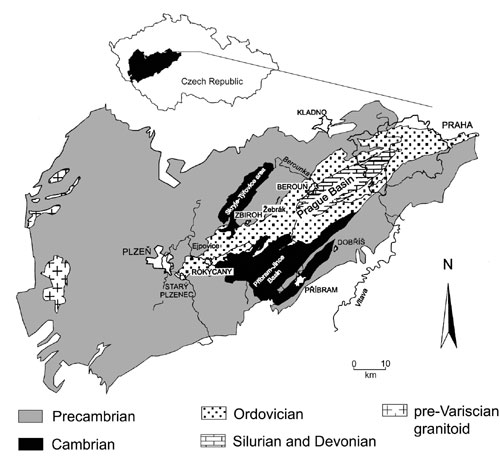
Trilobites of the Klabava Formation (Arenig), Prague Basin, Czech Republic: preliminary report
Jana Bruthansova1
1 Palaeontological Department, National Museum, Václavské nám. 68, Praha 1, 115 79, Czech Republic. E–mail: jana.bruthansova@nm.cz
Key words: Trilobites. Klabava Formation. Arenig. Prague Basin. Czech Republic.
Introduction
The Barrandian area is situated in the Bohemian Massif, in the Czech Republic. It contains sediments and volcanics of three major and distinctly different tectono–sedimentary megacycles: Proterozoic, Cambrian, and Ordovician–Devonian. The Ordovician rocks are developed continuously from the Tremadoc to the top of the Ashgill (Figure 1).
This paper deals with the trilobites of the Klabava Formation, which is of the Early/Middle Ordovician age (see Figure 1). It is composed of various successions of sediments (shales, siltstones, conglomerates, ferrolites) and volcanics (tuffites and, tuffs). Its fauna is dominated by brachiopod–rich assemblages (see Havlícek and Vanek (1966), Havlícek (1982) and Mergl, 1992). The trilobite specimens occur comparatively commonly at several stratigraphic levels, especially in the tuffs, tuffites, and greyish–green shales.
Trilobites of the Klabava Formation have been studied for almost 100 years, e.g., by Holub (1911, 1912) and Mergl (1991). Also, some trilobites of this formation have been revised or figured by Prantl and Pribyl (1948), Vanek (1959), Marek (1961), Horný and Bastl (1970) Kraft (1972) Pek (1977) Pek and Vanek (1989), and others. The aim of this contribution is to shortly outline the trilobite assembages of the Klabava Formation of all trilobites occurring in the Klabava Formation integrating those that have been previously omitted.
Trilobite occurrence and assemblages
In the Klabava Formation trilobites occur commonly only in localized assemblages and in differing stratigraphic levels, Mergl (1997). Moreover, three of the assemblages are clearly substrate dependent. The first resides in volcanics and includes Pliomerops lindaueri, rare Ectillaenus sp., and Solenopleuricea. It is in a dynamicshallow platform environment with relatively deep substrate (Mergl, 1983). The second assemblage is in a tuffaceous member with Geragnostus (Geragnostella) tullbergi, Asaphellus sp., Ectillaenus sp., Pseudopetigurus hofmanni, Pricyclopyge binodosa cyanea, Placoparia cambriensis, Zeliszkella (Ormathops) sp., Bohemolichas praecursor, and Odontopleurida. The assemblage is heterogenous and inhabited an offshore open shelf environment. Trilobites are the most common in the last assemblage that lived in a clay–rich shale, mostly in the Tetragraptus–Azygograptus Biozone. Genera Euloma, Symphysurus and asaphids dominate. It is probably also a heterogenous assemblage with elements washed out from the shallower parts of basin, e. g. Bohemolichas praecursor. This assemblage was called by the Euloma Assemblage, BA3 by Havlícek and Vanek (1990).

Figure 1. Stratigraphy of the Bohemian Ordovician. The correlation of British series and regional stages after Kraft et al. (2001).
The fauna of the Klabava Formation is allied to similar faunas of Avalonia (S. Wales) (genera Asaphellus, Bohemopyge, Colpocoryphe, Cyclopyge, Illaenopsis, Leiagnostus, Microparia, Ormathops, Placoparia, Pricyclopyge) and Armorica (Montagne Noire and Spain) (Asaphellus, Bohemopyge, Colpocoryphe, Cyclopyge, Degamella, Euloma, Leiagnostus, Kodymaspis, Microparia and others; Havlícek et. al., 1994). The relationships to faunas of Gondwana (N. Africa) are weaker than in Tremadoc (affined genera Asaphellus, Bohemopyge, Colpocoryphe, Ectillaenus, Illaenopsis, Microparia, Ormathops, Placoparia, and Pricyclopyge) or with Baltica faunas (Euloma, Geragnostus, and Leiagnostus).
Acknowledgements
This paper was prepared with financial support of the Grant Agency of the Czech Republic, project Nş. 205/02/0934. Prof. Ron Parsley and Dr. Petr Kraft kindly improved English of earlier version.
References
Havlícek, V. 1982. Ordovician in Bohemia: development of the Prague Basin and its benthic communities. Sborník geologických Ved, Geologie, 37: 103–136.
Havlícek, V. and Vanek, J. 1966. The biostratigraphy of the Ordovician of Bohemia. Sborník geologických Ved, Paleontologie, 8: 7–69.
Havlícek, V. and Vanek, J. 1990. Ordovician invertebrate communities in black–shale lithofacies (Prague Basin, Czechoslovakia). Vestník Ústredního ústavu geologického, 65 (4):223–236.
Havlícek, V., Vanek, J. and Fatka, O. 1994. Perunica microcontinent in the Ordovician (its position within the Mediterranean Province, series division, benthic and pelagic associations). Sborník geologických ved, Geologie, 46: 23–56.
Holub, K. 1911. Nová fauna spodního Siluru v okolí Rokycan. Rozpravy Ceské akademie císare Františka Josefa pro vedy, slovesnost a umení, Trída II /mathematicko–prírodnická/, 20(15): 1–19.
Holub, K. 1912. Doplnky ku faune Eulomového horizontu v okolí Rokycan. Rozpravy Ceské akademie císare Františka Josefa pro vedy, slovesnost a umení, Trída II /mathematicko–prírodnická/, 19(33): 1–12.
Horný, R. and Bastl, F. 1970. Type specimens of fossils in the National Museum Prague, I. Trilobita. Prírodovedecké muzeum: 1–356.
Kraft, J. 1972. Type specimens of fossils in the West–Bohemian Museum in Plzen and the Regional Museum of Dr. B. Horák in Rokycany. Part I – Trilobita. Folia Musei Rerum naturalium Bohemiae occidentalis, Geologica: 3–11.
Kraft, P., Kraft, J. and Prokop, R. J. 2001. A possible hydroid from the Lower and Middle Ordovician of Bohemia. Alcheringa, 25: 143–154.
Marek, L. 1961. The trilobite family Cyclopygidae Raymond in the Ordovician of Bohemia. Rozpravy Ústredního ústavu geologického, 28: 7–67.
Mergl, M. 1983. Rocky–bottom fauna of Ordovician age in Bohemia (Arenigian; Prague Basin, Barrandian area). Vestník Ústredního ústavu geologického, 58 (6): 333–339.
Mergl, M. 1991. New Lower Ordovician (Arenig) trilobite assemblages in Bohemia. Casopis pro mineralogii a geologii, 36 (4): 193–203.
Mergl, M. 1992. Orthid–brachiopod–dominated benthic communities of the Klabava Formation (Late Arenig) in the Prague Basin, Bohemia (taxonomy, taphonomy, palaeoecology). Folia Musei Rerum Naturalium Bohemiae Occidentalis, Geologica, 36: 1–49.
Mergl, M. 1997. Fauny a stratigrafie klabavského souvrství. In Kraft (Ed.). Záverecná zpráva grantu GA CR 205/94/0759. "Ceský ordovik jako stratigrafický standard pro mediterenní oblast". Díl 1: S26–S44.
Pek, I. 1977. Agnostid trilobites of the Central Bohemian Ordovician. Sborník geologických ved, Paleontologie, 19: 7–43.
Pek, I. and Vanek, J. 1989. Index of Bohemian trilobites. Krajské vlastivedné muzeum. 1–68.
Vanek, J. 1959. Celed Lichaidae Hawle et Corda, 1847 ze stredoceského staršího paleozoika (Trilobitae). Bohemia Centralis (A–Scientiae naturales), 1 (3): 81–163.
Received: February 15, 2003
Accepted: June 15, 2003